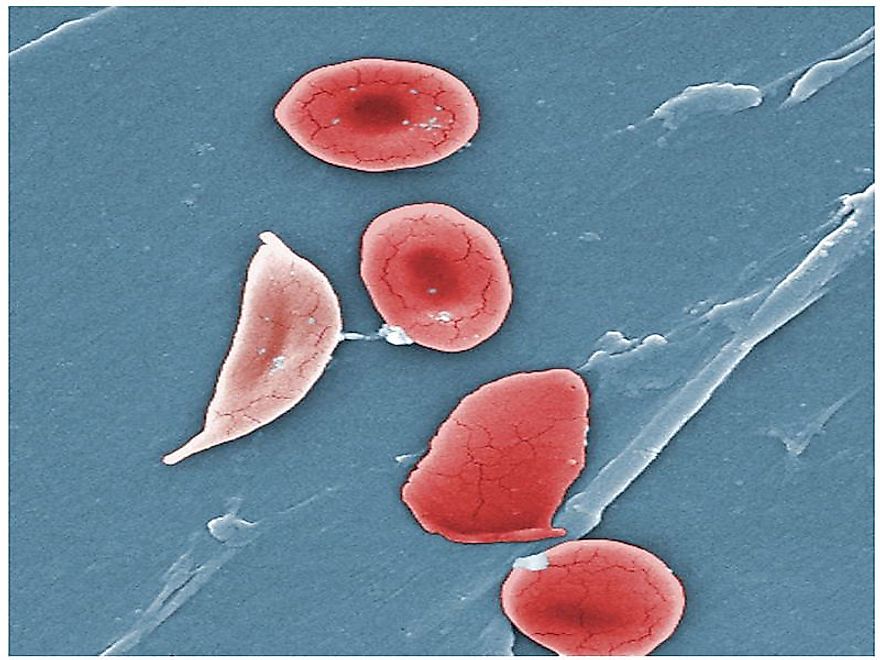Highest Numbers Of Sickle Cell Births By Country

Sickle cell anemia is a disease caused by the genetic inheritance of mutated alleles responsible for the condition. The genes responsible for sickle cell disease are located on chromosome 11. The genes inherited from the parents determines the type of hemoglobin the person makes in red blood cells (RBC). In the case of sickle cell, a mutation in a single nucleotide of the hemoglobin-Beta genes occurs resulting in the substitution of Glumatic acid by Valine at position-6.
Countries With The Highest Number Of Sickle Cell Births Per Year
Pathophysiology
Whereas a single allele (Heterozygous Hgbs) is capable of producing more than 50% of the hemoglobin, inheritance of both alleles, (homozygous Hgbs) distorts the shape of RBC from flat disk-shaped cells to sickle-shaped cells. These distorted RBC's are unable to carry enough oxygen to attend to the needs of the body, degrade quickly and also block capillaries, leading to improper distribution of blood to various organs and tissues of the body.
Symptoms Of The Disease
People with sickle cell anemia suffer from periods of pain called crises. The intensity of the pain varies among different people from a few episodes to more in a year. The pain results from the blocked capillaries. Anemia results when the condition leaves the body with lasting fewer amounts of red blood cells. Fatigue follows due to less circulating oxygen in the blood capillaries. In babies, the hand-foot syndrome may develop when the blood vessels are blocked. Other symptoms of the disease include frequent infections, stunted or delayed growth, and vision problems. Sickle cell anemia results in loss of spleen function, leading to increased risk of severe bacterial infections.
Progressive narrowing of blood vessels may lead to symptomatic stroke due to insufficient brain oxygen supply.In children, cerebral infarction occurs and cerebral hemorrhage in adults. A silent stroke also occurs predominantly in younger patients, whereas 10-15% of SCD children suffer from an asymptomatic stroke. Silent strokes cause severe brain damage. In pregnant women the symptoms are more pronounced, resulting in spontaneous abortion and intrauterine growth retardation.
Epidemiology
The disease is predominant in tropical regions of sub-Sahara Africa where malaria is endemic. In the European countries, migration of the tropical and subtropical people increased the number of deaths due to SCD from 113,000 to 176,000 by 2013.
The occurrence of the disease is high in Africa due to the predominance of malaria. The disease is more dominant 10-40%, in equatorial countries of Africa and less 1-2%, in North Africa and less than 1% in South Africa. West African countries report the highest prevalence of about 25% of the population.
Nigeria records the highest disease incidence in the world with approximately 91,011 children born with the defect. The rate accounts for almost 2% of all newborns annually. The Democratic Republic of Congo comes seconds with a 39,743 sickle cell births per year. Studies indicate that the number in Nigeria and Congo is likely to increase to approximately 140000 and 45000, respectively by the year 2050. Tanzania follows with 11,877, Uganda with 10,877, Angola with 9,017, Cameroon with 7,172, Zambia 6,039, and Ghana, guinea, Niger recording less than 6,000 sickle cell births per year. Researchers indicate that occurrence of the disease decreases early mortality rate (2-16 years) especially in areas where malaria is endemic.
Association Of SCD With Malaria
The presence of sickle cell genes results in two conditions: sickle cell disease or sickle cell trait. In SCD, the person has two abnormal copies of a gene while sickle cell trait has one mutated allele. The former results in disease, while the latter, protects against malaria.
Sickle cell trait is advantageous to people in malaria-prone areas as it provides a survival tactic to the affected. The natural selection process has selected sickle cell trait as a protective measure against malaria that is highly prevalent in Africa, but when an individual inherits two mutated copies of the gene, the individual suffers from the SCD. The sickle cell trait is advantageous if the causative agent is Plasmodium falciparum. However, people with normal hemoglobin are prone to infections and in this category infant mortality is high.
Research indicate that presence of the disease provides 50% advantage against mild clinical malaria, 75% protection against hospital admission, and 90% against severe and complicated malaria.
How The Sickle Cell-Shaped RBC Protects Against Malaria
A sickle cell shaped RBC has a deformed shaped with increased cellular oxygen tension.When the cells are infected, the parasite lowers the oxygen stress, resulting to sickling of that erythrocyte.The phagocytes then rid the body of the cell and hence the parasite within. The reticuloendothelial system also selectively removes parasite-infected cells. Also, cells with the sickle cell traits produce higher levels of hydrogen peroxide and superoxide anion, which are toxic to the malaria parasite.
A Disease With No Cure
Sickle cell has no cure. Managing the disease protects future children from infection. Apart from Africa, the United States, and the UK follow with increased disease incidence. The migration of people from Sub-Sahara Africa to other continents enhances the occurrence of sickness in those particular countries. In the European countries, the presence of sickle cell traits and SCD has lead to reduced occurrence of the common blood disorders like cystic fibrosis.
Countries With The Highest Number Of Sickle Cell Births Per Year
| Rank | Country | Sickle Cell Births/Year |
|---|---|---|
| 1 | Nigeria | 91,011 |
| 2 | Democratic Republic Of Congo | 39,743 |
| 3 | Tanzania | 11,877 |
| 4 | Uganda | 10,877 |
| 5 | Angola | 9,017 |
| 6 | Cameroon | 7,172 |
| 7 | Zambia | 6,039 |
| 8 | Ghana | 5,815 |
| 9 | Guinea | 5,402 |
| 10 | Niger | 5,310 |











